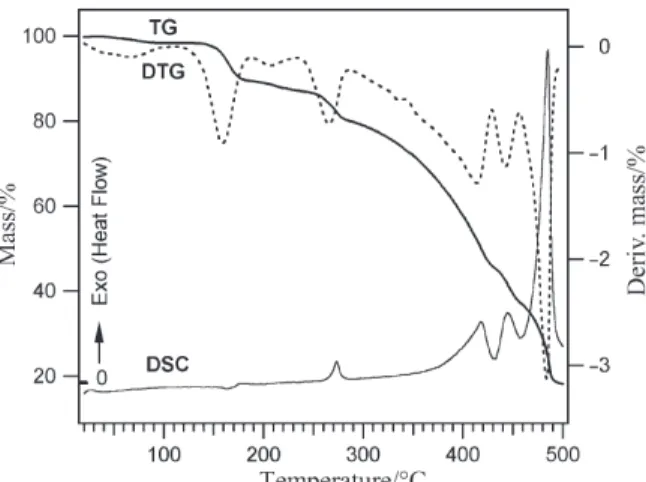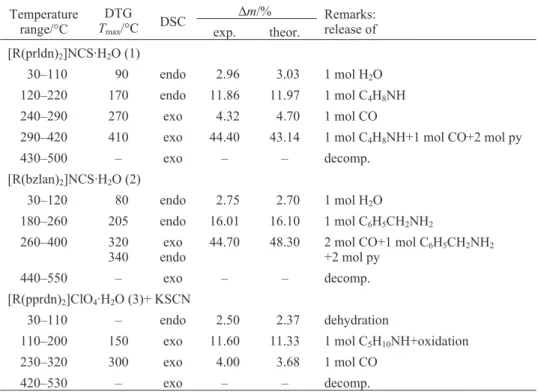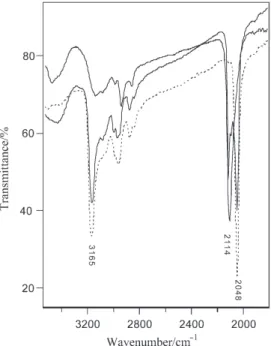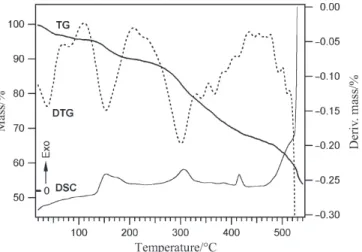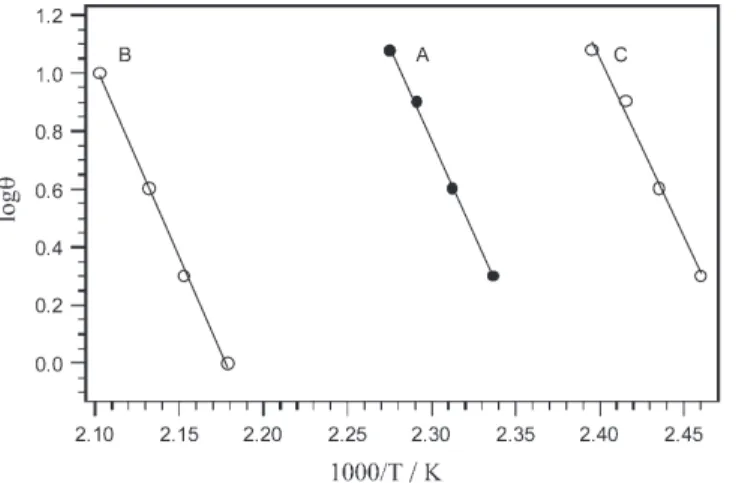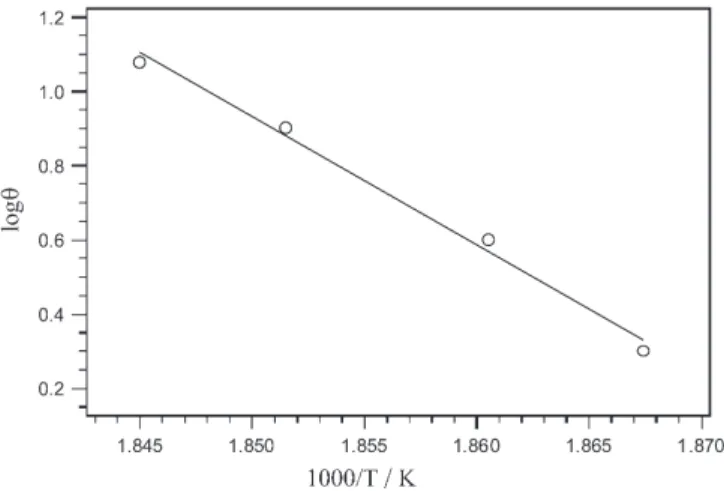THERMAL DEAMINATION-ANATION IN COBALT(III)
THIOCYANATE COMPLEXES
Novel decarbonylation of the equatorial amide ligand
M. Amirnasr
1*, R. Houriet
2and S. Meghdadi
31Institute of Physical Chemistry, Swiss Federal Institute of Technology, CH-1015 Lausanne,
Switzerland
2Department of Materials Science, Swiss Federal Institute of Technology, CH-1015 Lausanne,
Switzerland
3Department of Chemistry. Isfahan University of Technology, Isfahan 84154, Iran
(Received April 9, 2001; in revised form July 9, 2001)
Abstract
The solid state thermal behavior of trans-[Co(bpb)(amine)2]NCS·H2O complexes where (bpb)=
[N,N’-bis(2-pyridinecarboxamido-N)-1,2-benzene], and amine=pyrrolidine (prldn) (1), and benzyl-amine (bzlan) (2), and trans-[Co(bpb)(piperidine)2]ClO4·H2O (3) (mixed with KSCN), has been
stud-ied using thermoanalytical techniques, infrared spectroscopy, and pyrolysis coupled to both infrared and mass spectrometry, PY/FTIR and PY/MS. The deamination-anation reaction is clearly observed for all three complexes. The estimated values of Ea for the deamination-anation are: Ea(1)=
246.8 kJ mol–1, E
a(2)=255.7 kJ mol–1, Ea(3)=234.7 kJ mol–1. The trend in Eavalues is rationalized based
on the ligand field strength of the amines and the structural effects. A novel decarbonylation of the am-ide CO group from the equatorial ligand is observed after the release of one amine molecule. This pro-cess has been monitored for complex (1) by FTIR in the carbonyl region and by mass spectrometry for the detection of CO2 at 280°C. The activation energy of this process is estimated for complex (1)
(662.5 kJ mol–1). The reaction scheme for the observed reactions is proposed.
Keywords: amide decarbonylation, cobalt(III) complexes, deamination-anation, kinetics, NCS
counterion
Introduction
Thiocyanate has a special place among small anionic ligands. Its role in thermal de-amination-anation reactions of many transition metal complexes in solid state has been studied [1–5] and the kinetics of these reactions has been reviewed [6]. We have recently
* On sabbatical leave from Department of Chemistry, Isfahan University of Technology, Isfahan 84154, Iran
Author for correspondence: Phone : +98-311-3912351, Fax : +98-311-3912350, E-mail: amirnasr@cc.iut.ac.ir
synthesized a series of trans-[Co(acacen)(amine)2]NCS complexes
(acacen=N,N’-ethylenebis(acetylacetoneiminato) dianion) [7], and studied the kinetics of their deamination-anation reactions by thermogravimetric techniques and IR spectroscopy [8]. The electronic and structural effects of different equatorial ligands on the kinet-ics of deamination-anation reactions are quite interesting [9]. As an extension of our earlier studies on Schiff-base cobalt(III) complexes [7, 10], we have synthesized and determined the structure of trans-[Co(bpb)(amine)2]X·H2O complexes (1), (2) and
(3) [11]. The electronic and structural properties of these complexes are different from those of the acacen analogues, therefore influencing the thermal properties of these complexes. Here we report the results of our thermoanalytical studies of these complexes in dynamic air atmosphere. The thermal behavior under nitrogen is lim-ited to the deamination-anation followed by the overlapping decomposition of all or-ganic fragments. The kinetic parameters of deamination-anation of (1) , (2) and (3) (mixed homogeneously with KNCS) and the decarbonylation of the amide ligand for (1) in air are estimated. The effect of the intermolecular hydrogen bonding (Fig. 1) on the decarbonylation of the equatorial ligand is also discussed.
Experimental
The cobalt complexes were prepared as reported elsewhere [11]. Infrared spectra were recorded as KBr pellets with a Perkin Elmer Paragon 1000 FTIR instrument. TG and DSC were performed using Mettler TA 4000 and Rheometric Scientific STA 1000 thermal analyzers. TG experiments were carried out in a dynamic atmosphere (20 mL min–1) of air or nitrogen with a heating rate of 1–10°C min–1. TG and DSC
curves were recorded by heating the samples ca 2.5–10 mg of the complex up to about 550°C. Indium was used as reference to calibrate the temperature and heat flow. PY/MS experiment was performed using a Pyroprobe 2000 (CDS Instruments)
Fig. 1 X-ray crystal structure of trans-[Co(bpb)(prldn)2]NCS·H2O complex, showing
pyrolizer coupled to a quadrupole mass filter (Thermolab, TA Instruments) via a heated silica capillary interface. PY/FTIR experiments used the Pyroprobe 2000 pyrolizer coupled to a home-made infrared gas cell of 65 mm pathlength equipped with KBr windows.
Results and discussion
Thermal behavior of complex (1)
The thermoanalytical data for complex (1) are given in Table 1. The combined TG, DTG, and DSC curves of (1) in dynamic air atmosphere, with heating rate of 5°C min–1, are shown in Fig. 2. Four well defined steps can clearly be observed, in the
TG and DTG curves. The first between 30–110°C is associated with the endothermic loss of water accompanied by 2.96% mass loss (H2O=3.03 %). This step is common
to all three complexes and is similar to the dehydration of many other complexes with water of crystallization [5]. The second step between 120 and 220 °C belongs to the endothermic deamination-anation reaction represented by Eq. (1).
→
trans-[Co(bpb)(amine)2]NCS∆ trans-[Co(bpb)(amine)(NCS)]+amine (1)
The mass loss in this step is 11.86% (pyrrolidine=11.97%) and during this endo-thermic process, one of the axial pyrrolidine ligands is replaced by NCS.
The substitution of the amine by NCS in this step is accompanied by characteris-tic changes in the intensity of the N–H stretching band at 3165 cm–1and a
consider-able shift in the position of the thiocyanate stretching band in the IR spectra from 2048 for the thiocyanate counterion to 2114 cm–1for the coordinated NCS, Fig. 3. As
the deamination–anation reaction proceeds, the intensity of the peak at 2114 in-creases on the expense of the decrease in the intensity of the peak at 2048 cm–1. This
new band is assigned to a coordinated NCS group [12] and clearly indicates that the
NCS ligand is coordinated to the metal center in the deamination-anation reaction. The IR spectrum of complex (1) after prolonged heating at 150°C is similar to that of trans-[Co(bpb)(prldn)(NCS)] complex produced by direct synthesis [11].
Table 1 Thermoanalytical data for the thermal behavior of complexes (1)–(3) in dynamic air
at-mosphere at 5°C min–1heating ratea
Temperature range/°C TDTGmax/°C DSC ∆m/% Remarks: release of exp. theor. [R(prldn)2]NCS·H2O (1) 30–110 90 endo 2.96 3.03 1 mol H2O 120–220 170 endo 11.86 11.97 1 mol C4H8NH 240–290 270 exo 4.32 4.70 1 mol CO
290–420 410 exo 44.40 43.14 1 mol C4H8NH+1 mol CO+2 mol py
430–500 – exo – – decomp.
[R(bzlan)2]NCS·H2O (2)
30–120 80 endo 2.75 2.70 1 mol H2O
180–260 205 endo 16.01 16.10 1 mol C6H5CH2NH2
260–400 320
340 endoexo 44.70 48.30 2 mol CO+1 mol C+2 mol py 6H5CH2NH2
440–550 – exo – – decomp.
[R(pprdn)2]ClO4·H2O (3)+ KSCN
30–110 – endo 2.50 2.37 dehydration
110–200 150 exo 11.60 11.33 1 mol C5H10NH+oxidation
230–320 300 exo 4.00 3.68 1 mol CO
420–530 – exo – – decomp.
aR=CoIII(bpb)
An interesting observation in the thermal behavior of (1) is the loss of one of the am-ide C=O groups from the equatorial ligand between 240–290°C. This exothermic reac-tion takes place in the third step when the intermolecular N–H···O=C hydrogen bonding breaks apart in the deamination process and one of the two amide C=O groups per com-plex molecule is no longer engaged in hydrogen bonding. It is evident from the DSC curve (Fig. 2) that, no detectable structural transformation associated with further N–H···O=C hydrogen bond rupture occurs prior to decarbonylation. The endothermic dissociation of such relatively strong H-bonds (H···O=2.319 Å) will probably show endo-thermic peaks in the DSC curve. The mass loss in this step is 4.32% (CO=4.70%) and during this exothermic process only one CO group, free from hydrogen bonding, is oxi-dized to CO2according to Scheme 1. The conversion of CO to CO2, is confirmed by
monitoring the evolution of CO2 in this temperature range using temperature
band at 1623 cm–1by PY/FTIR technique. The second CO group of the equatorial ligand,
which remains engaged in hydrogen bonding with the second axial amine, is oxidized af-ter the release of the second amine ligand, overlapping with the loss of the two pyridine residues. The total observed mass loss for these overlapping steps are 44.4 as compared to the calculated values of 43.14% for (pyrrolidine+CO+2py). The release of the rest of the ligands is accompanied by total decomposition of the sample as shown by an expres-sive exothermic peak on DSC curve at 480°C.
Thermal behavior of complex (2)
The thermoanalytical data for complex (2) are listed in Table 1. The combined TG, DTG, and DSC curves of complex (2) in a dynamic air atmosphere are shown in Fig. 4. Similar to complex (1), the first and the second steps, which take place in the temperature ranges 40–120 and 180–260°C, belong to the dehydration and deamination-anation processes, respectively. The observed mass loss in the first step is 2.75 as against the calculated value of 2.70% for the release of H2O. In the second
step, one of the axial benzylamine molecules splits off with a mass loss of 16.01 as against the calculated value of 16.10%. The third step, which by analogy to com-plex (1), is the decarbonylation of one CO group from the equatorial ligand, begins at 270°C. This step is immediately followed by several overlapping steps including the release of the second benzylamine molecule, the decarbonylation of the remaining equatorial ligand, and the release of the two pyridine residues. The observed mass
Fig. 3 Infrared spectra of (1) before heating – – –, after 3 h —, and after prolonged —,
loss between 260–400°C is 44.7 as against the calculated value of 48.30% for (benzylamine+2CO+2py). The rest of the ligands are exothermically decomposed along with the total decomposition of the sample at above 450°C.
Thermal behavior of complex (3)
To study the thermal behavior of a bis(piperidine) complex similar to (1) and (2), it was desired to synthesize the trans-[Co(bpb)(pprdn)2]NCS compound. However, our
attempts led to a mixture containing a high percentage of the thermal anation product, trans-[Co(bpb)(pprdn)NCS]. Therefore, a homogeneous mixture of the perchlorate salt, trans-[Co(bpb)(pprdn)2]ClO4·H2O, and KSCN was used for thermal
deami-nation-anation studies. The thermoanalytical data for complex (3)+KSCN are listed in Table 1 and the combined TG, DTG, and DSC curves of this mixture in a dynamic air atmosphere are presented in Fig. 5. The thermal behavior of complex (3)+KSCN mixture in air atmosphere, is very close to the other two complexes (1) and (2). How-ever the dehydration process consists of two very close steps associated with succes-sive release of the adsorbed and crystallization water between 30 and 110°C. In the second step between 110 and 200°C, piperidine molecule is replaced by NCS. The observed mass loss in this step is ca 11.60 as compared to the calculated value of 11.20% for piperidine. It is worth noting that, since the organic molecules are readily oxidized in air in the presence of perchlorate at elevated temperatures, the endother-mic release of piperidine is probably counterbalanced by the exotherendother-mic oxidation of this amine, resulting in an exothermic peak in the DSC curve, Fig. 5. The decar-bonylation of (3) occurs between 230 and 310°C with the observed mass loss of ca. 4.0 as compared to the theoretical value of 3.68% for the release of CO. Other pro-cesses at higher temperatures are complicated by the oxidative nature of the perchlor-ate anion. However it is noteworthy that the qualitative thermal behavior of (3) mixed
with KSCN resembles that of (1), though the presence of the perchlorate anion results in the exothermic oxidation of all organic fragments released at high temperatures, and rough estimation of the mass loss.
Kinetic and mechanism of the reactions
The thermal behavior of the cobalt complexes can be expressed briefly as shown in Scheme 1. The steps outlined in Scheme 1 are more clearly observed in the thermal decomposition of complex (1). In the case of (2) and (3) however, it seems that some successive steps overlap to a great extent or occur all at once.
Fig. 5 TG, DTG, and DSC curves of (3)+KSCN in a dynamic air atmosphere (20 mL min–1)
TG, DTG, and DSC curves provide comprehensive information about the reaction stoichiometry and the temperatures at which different reactions take place. It is evident from these curves that the deamination-anation reaction occurs at a higher temperature for the complex in which the axial amine has a higher ligand field strength. A higher acti-vation energy is also expected for the substitution of the more strongly coordinated amine. In order to estimate the activation energy of the deamination reaction, the temper-ature (Tm) at maximum mass loss (DTG) in the deamination process for each complex
was determined as a function of heating rate (θ) applied, from the thermoanalytical curves. The activation energies were directly estimated [13] from the slope of the graph logθvs. 1/Tm(Fig. 6) according to the Eq. (2).
Ea= –2.303R[d(logθ)/d(1/T)] (2)
The estimated values of Ea(1)=246.8 kJ mol–1, Ea(2)=255.7 kJ mol–1, and
Ea(3)=234.7 kJ mol–1, show a trend similar to that observed in the energy of the first
ligand field (LF1) transition (ca 10 Dq) of these hexacoordinate complexes. The
E(LF1)=15.823 kK (λmax=632 nm) for (1), 16.565 kK (λmax=604 nm) for (2), and
14.815 kK (λmax=675 nm) for (3), have been determined from the UV-Vis spectral
measurements [11].These observations are in accordance with the expectation con-sidering a dissociative activation process for ligand substitution in the low spin d6
Co(III) complexes [14–16].
It is interesting to note that the activation energies of deamination-anation of (1)–(3) are, in general, higher by about 100 kJ mol–1than those of the corresponding
trans-[Co(acacen)(amine)2]NCS complexes [8]. A comparison between the
elec-tronic spectra and the structure of these complexes would make it possible to rational-ize these observations. It is evident from the electronic absorption spectra of (1)–(3) that bpb is a tetradentate ligand with a lower ligand field strength compared to acacen, due to its lower electron donating character. The decreased bonding interac-tion between the equatorial ligand and Co(III) promotes the affinity for axial ligands.
A stronger interaction between Co(III) metal center and the axial amines, and a rela-tively strong intermolecular N–H···O=C hydrogen bonding (Fig. 1) may well account for the higher Eaof deamination-anation of (1)–(3) relative to the acacen analogues.
The decarbonylation of the coordinated equatorial ligand contrasts the thermal behavior observed for the free ligand and the O-bonded amide complexes reported in the literature [17]. While the free ligand undergoes endothermic melting at 175°C fol-lowed by the endothermic evaporation at 275°C, the overall thermal stability of the coordinated ligand is increased due to the chelate effect. However, the amide linkage is weakened to some extent and undergoes pyrolysis at elevated temperatures in air to give CO2. The exothermic release of CO2, accompanied by the production of
isocyanates (R–N=C=O), is also reported in the thermal decomposition of cyclic amides in air [18]. The mechanism of the reaction may include an intramolecular re-arrangement followed by oxidative conversion of CO to CO2. The decarboxylation of
the carboxylic groups attached to strongly coordinated ligands is a normal process to occur at high temperatures [19, 20]. The decarbonylation temperature in complex (1) (270°C) is close to those for the coordinated carboxylic acid derivatives [20, 21]. In addition, the energy of activation for this process in complex (1), Ea=662.5 kJ mol–1
estimated from Fig. 7, is close to that reported for the hexacoordinate tris(mandelato)-thallium(III) complex [21]. The concomitant rearrangement and decarboxylation processes may well account for this relatively high activation en-ergy. Supporting evidence for the loss of one CO group comes from the mass loss (TG), the heat flow (DSC) in this exothermic step, Table 1, and the detection of CO2
by mass spectrometry at 280°C for complex (1).
Conclusions
Thermoanalytical investigation of the title complexes shows that the deamination-anation reaction takes place in a dissociative process resulting in the replacement of one of the axial amines by NCS. The trend in the activation energy for this process follows the ligand field strength of the coordinated amines: bzlan › prldn › pprdn [11]. This is consistent with a dissociative activation process. In addition, the observed higher activation energy relative to similar cobalt(III) acacen complexes [8] is ex-plained by the stronger interaction of the axial amine ligands with Co(III) and a rela-tively strong intermolecular hydrogen bonding between the amine and the CO group of the equatorial ligand, bpb, in these complexes.
The most interesting aspect of this study is the exothermic decarbonylation of the coordinated equatorial amide ligand as compared to the endothermic melting and evaporation processes of the free ligand. This is presumably due to the fact that the bonding between the CO group and the pyridine and phenylenediamine moieties are weakened to some extent upon coordination of the ligand to Co(III). This speculation remains to be tested by further theoretical studies.
* * *
Financial support from Isfahan University of Technology and the Ministry of Higher Education of Iran for sabbatical leave at EPFL, Lausanne, is gratefully acknowledged by M. Amirnasr. Strong ac-knowledgement is due to Prof. M. Grätzel for providing the chemicals and the laboratory space dur-ing the sabbatical period at ICP II, EPFL. The authors would also like to thank Dr. P. Bowen of the Materials Science Department, EPFL, for helpful discussions, and M. Donnet for his assistance in thermoanalytical measurements.
References
1 J. Zsakó, M. Várhelyi and Cs. Várhelyi, Thermochim. Acta, 51 (1981) 277. 2 J. A. Real, M. C. Munzo and J. Borras, Thermochim. Acta, 101 (1986) 83. 3 Z. Liming, D. Lide and X. Xinquan, Thermochim. Acta, 196 (1992) 437.
4 E. Jóna, M. Kubranova, P. Simon and J. Morzinski, J. Thermal Anal., 46 (1996) 1325. 5 D. Czakis-Sulikowska and J. Ka³uzna, J. Thermal Anal., 47 (1996) 1763.
6 J. E. House Jr., Coord. Chem. Rev., 128 (1993) 175.
7 M. Amirnasr and R. Vafazadeh, Scientia Iranica, 4 (1997) 35. 8 M. Amirnasr and R. Vafazadeh, Scientia Iranica, 4 (1997) 46. 9 M. Corbella and J. Ribas, Inorg. Chem., 25 (1986) 4390.
10 M. Amirnasr, K. J. Schenk, A. Gorji and R. Vafazadeh, Polyhedron, 20 (2001) 695. 11 M. Amirnasr, K. J. Schenk and S. Meghdadi, submitted to Inorg. Chim. Acta.
12 K. Nakamoto, ‘Infrared and Raman Spectra of Inorganic and Coordination Compounds’ 4th ed.; John Wiley & Sons, New York 1986, p. 285.
13 T. Ozawa, J. Thermal Anal., 7 (1975) 601.
14 R. G. Wilkins, ‘Kinetics and Mechanism of Reactions of Transition Metal Complexes’ 2nd ed., VCH Weinheim, New York 1991, p. 94.
15 A. Haim, Inorg. Chem., 9 (1970) 426. 16 N. J. Curtis, Inorg. Chem., 25 (1986) 1033.
17 A. N. Nelwamondo, D. J. Eve, G. M. Watkins and M. E. Brown, Thermochim. Acta, 318 (1998) 165.
18 C. Shimasaki, H. Nakayama, A. Iwaki, E. Tsukurimichi, T. Yoshimura and K. Hasegawa, Bull. Chem. Soc. Jpn., 65 (1992) 1993.
19 J. C. Bezial, M.Besson, P. Gallezot and S. Durecu, J. Catal. 182 (1999) 129.
20 M. Amirnasr, Md. K. Nazeeruddin and M. Graetzel, Thermochim. Acta, 348 (2000) 105. 21 P. V. Khadikar, Thermochim. Acta, 116 (1987) 171.
![Fig. 1 X-ray crystal structure of trans-[Co(bpb)(prldn) 2 ]NCS·H 2 O complex, showing NH···O=C intermolecular hydrogen bonding](https://thumb-eu.123doks.com/thumbv2/123doknet/14833898.621204/2.892.261.626.717.973/crystal-structure-trans-complex-showing-intermolecular-hydrogen-bonding.webp)
